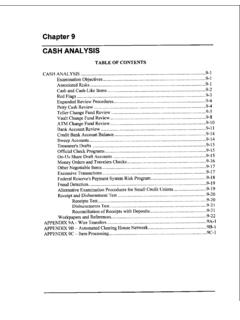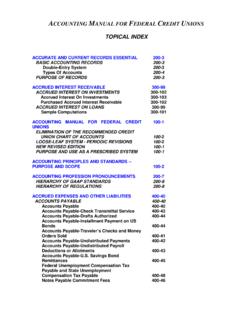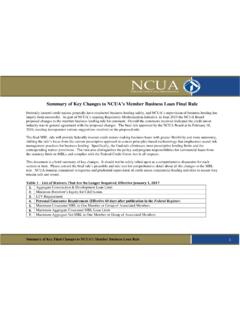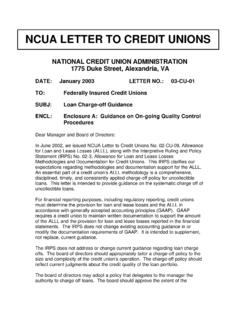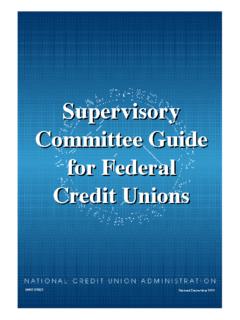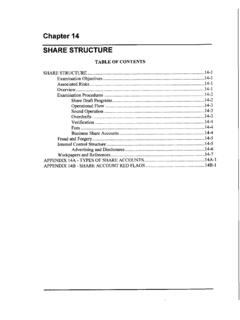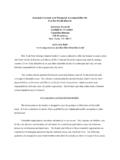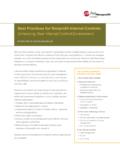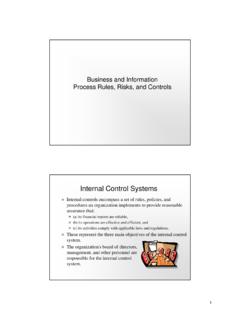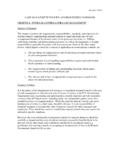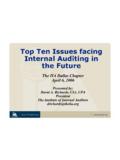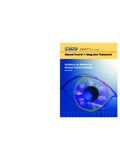Transcription of Chapter 4 - Examiners Guide - NCUA Homepage
1 Chapter 4 internal CONTROLS TABLE OF CONTENTS internal CONTROLS .. 4-1 Examination Objectives .. 4-1 Associated Risks .. 4-1 Overview .. 4. 1 Safety and Soundness .. Accurate Financial Statements .. Other Laws and Regulations .. internal control Components .. control Environment .. Risk Assessment .. 4-5 control Activities .. control Systems .. 4-7 Self-Assessment or Monitoring .. internal control Evaluation .. Strategic Risk .. 4-8 Transaction Risk .. Compliance Risk .. 4. 10 Reputation Risk .. 4.
2 10 Workpapers and References .. 4-12 APPENDIX 4A . Conflicting Management Positions ..41 A. APPENDIX 4B . Information System (IS) Reports .. 4B-1 3" w Chapter 4 internal CONTROLS Examination Objectives 0 Determine whether the credit union has implemented efficient and effective operations and risk management systems Determine whether the credit union accurately records transactions Determine timeliness and reliability of financial reporting Determine whether the credit union complies with regulations, internal policies.
3 And internal procedures Assess whether the credit union has implemented adequate internal controls to safeguard assets 0 0 0 0 Associated Risks 0 Strategic risk occurs when management fails to (1) perform necessary due diligence as it applies to internal controls surrounding existing and proposed products and services, (2) act on recommendations included in examinations and internal /external audit reports, and (3) allocate the necessary resources to implement proper internal controls; Transaction risk occurs when internal controls do not sufficiently deter or detect errors, omissions, or material misstatements; Compliance risk occurs when the credit union fails to adhere to applicable laws and regulations; and Reputation risk occurs when management fails to meet its fiduciary duties, resulting in poor publicity or administrative action.
4 0 0 0 Overview internal control is defined as a process, developed by a credit union's board of directors, management, and other personnel, designed to provide reasonable assurance regarding the achievement of objectives in the following categories: 0 0 0 Effectiveness and efficiency of operations; Reliability of financial reporting; and Compliance with applicable laws and regulations. internal control does not guarantee that the entity will achieve its objectives or even remain in business. Rather, internal control provides Page 4-1 EXAMINER'S Guide management with reasonable assurance regarding the achievement of objectives.
5 Inherent limitations to internal control exist and costhenefit considerations will prevent implementation of all possible controls. Inherent limitations may also limit the effectiveness of internal controls. 3 1 13 of the FCU Act states that the board of directors shall have the general direction and control of the affairs of the credit union, including the proper and profitable conduct of credit union operations, the safety of credit union assets, and the accuracy and adequacy of financial statements. The board retains overall responsibility for the affairs of the credit union.
6 As part of that responsibility, the board establishes internal controls, which include organizational plans, policies, and operating procedures to maintain control over the duties delegated to paid employees. internal control systems assist management with the following: 0 Measuring performance, making decisions, evaluating processes, and managing risks; Achieving its objectives and avoiding surprises; and Detecting mistakes caused by personal distraction, carelessness, fatigue, errors in judgment, or unclear instructions in addition to fraud or deliberate noncompliance with policies.
7 0 0 Effective and well-designed control systems are still subject to execution error. In other words, human beings still must execute most control systems and even well trained personnel with the best of intentions can become distracted, careless, tired or confused. Consistent application and thorough understanding of internal control by credit union personnel can determine the effectiveness of board and management policies. Controls typically (1) limit authorities, (2) safeguard access to and use of records and credit union assets, (3) separate and rotate duties, and (4) ensure both regular and unscheduled reviews, including testing.
8 Safety and Soundness The FCU Act and the bylaws establish the basic organizational pattern for credit unions. A credit union's growth necessitates further divisions Page 4-2 internal CONTROLS of duties and responsibilities. The following organizational procedures enhance the attainment of internal control : 0 Approval of loan applications by a separate credit committee elected by the members or appointed by the board, or by a loan officer appointed by the credit committee or the board; 0 The signing and countersigning of checks and notes by a person other than a disbursing officer.
9 0 Approval of membership applications by the board, executive committee, or membership officer, rather than by the paid board officer, the financial officer, any assistant to the paid board officer or financial officer, or a loan officer; 0 internal audits by the supervisory committee or internal auditor conducted independently of any official or employee; and 0 Maintenance of separate lists of accounts opened and closed for the information of the directors and supervisory committee by persons other than those handling the accounting records.
10 The bylaws and Supervisory Committee Guide for Federal Credit Unions contain other examples and information for achieving control through organization. (Appendix 4A, Conflicting Management Positions, addresses prohibited positions within the credit union and the officers or employees.) Accurate Financial Statements Essentially, the accounting system provides a credit union s management with the complete and accurate financial information needed to conduct sound and effective operations. Management uses financial statements produced by the system to report to the members, creditors, insurers, and NCUA.
